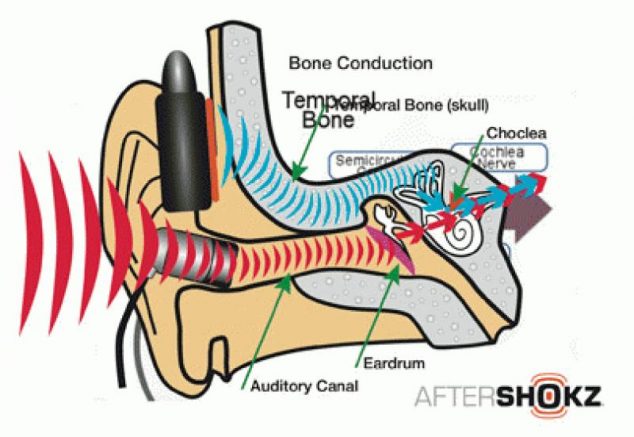No products in the basket.
Blog
What is bone conduction?
Bone conduction has been an upcoming term and trend the past years. Bone conduction was introduced for the first time to the general public in 2010 when the Bluetooth Orb made its appearance. Nowadays bone conduction is a technology used by many companies as a vital part in the development of various products such as top-of-the-bill headphones, modern hearing aids and other hearing aids. You probably already know it as an alternative to the classic earplugs, which you literally plug into your ear, but when you, like most of us, took a little nap during biology class, this is where the knowledge ends and you are probably not able to answer the question “What is bone conduction?” and you are certainly not able to provide a reply to “How does Bone conduction work?”. Time to answer these questions once and for all!
Table of Contents
What is bone conduction
Bone conduction can be taken literally. Instead of transmitting sound directly to the eardrums, the sound gets transported through your skull bones, directly into the inner ear. Sounds complicated? Well, it may surprise you but bone conduction is in fact a natural process, taking place every time we speak. Because sound gets picked up before leaving your mouth, it gets sent through the jawbone and next instantly to your inner ear. This is one of the reasons why your voice has a higher pitch when listening to recordings, compared to when you hear yourself talk. Because bone conduction creates a deeper and high-pitch sound, you also hear yourself using a deeper and high-pitch voice. So, we answered two questions in one go: “What is bone conduction?” and “Why does a recorded voice sound different to the ears?”.
How does bone conduction work?
You are probably aware that sounds travels and is transmitted through the air by means of so-called waves. You are probably also aware that when a sound reaches your eardrum, it gets transformed into a series of vibrations. When sound enters the ear, the ear shell pushes it further into our ear through the ear canal and onto the eardrum. This eardrum starts vibrating, whereby the vibrations differ depending on the sort of sound. These vibrations reach three small bones (the hammer, the anvil and the stirrup) who then transport the sound to the middle ear. In the middle ear the sound reaches the cochlea, a space filled with liquid that converts the vibrations into electrical signals that are sent to our brain where they are identified as sound. This is what we could call the traditional way of hearing. Bone conduction on its turn skips the whole initial process and the vibrations are immediately transmitted through the jawbone to the cochlea, skipping your outer and middle ear and keeping your eardrums free to pick up other sounds.
The benefits of bone conduction
Bone conduction has a number of benefits compared to your typical audio aids, such as the fact that you don’t need an in-ear or over-ear headphone. This way the user can listen to music or other audio without having to miss the ambient sounds. Thanks to bone conduction headphones you remain aware of your surroundings while listening to music or making a call. Moreover you won’t have that unpleasant feeling of annoying and often irritating earplugs in your ears. Bone conduction works perfectly for people with a hearing disability, people wearing earplugs and even for people who almost lost their entire hearing capabilities. Because bone conduction skips the outer and middle ear, it is possible for people with hearing disabilities to use a bone conduction headset to regain their hearing.
Interested to know more about the benefits? Take a look at “The Benefits of Bone Conduction”
The disadvantages of bone conduction
While bone conduction certainly has a lot of benefits, it is not 100% perfect yet. One of the downsides is the fact that more power is needed compared to standard audio to push the sound to your brain, there are less frequencies and sometimes you end up with cross talk. Despite this, the benefits outweigh the disadvantages more than enough causing bone conduction to slowly conquer the world of headphones and other audio equipment.
Time to buy a bone conduction headphone?
We at www.bone-conduction.com have tested various different bone conduction headphones ourselves, and we can honestly say that a bone conduction headphone is worth it’s money these days. The costs have lowered drastically while the quality has significantly improved. Thanks to the outstanding sound quality, a bone conduction headphone can almost match the sound of a classic headphone. Are you only looking at sound quality we would suggest to go for a classic headphone, but are you looking for quality, innovation, safety and comfort…bone conduction headphone is the way to go.
When you are looking to buy a high-quality bone conduction headphone, you will need to have a budget of 100 – 200 euros (100 – 150 Dollars). We are big fans of the AfterShokz Trekz Titanium and the AfterShokz Trekz Air ourselves.

Wim Styleman is a content writer, translator, reviewer and bone conduction fanatic. Interested in the wonderful world of bone conduction since 2016. Driven by a desire to get everyone submerged into this wonderful technology, but critical and honest when he has to be as a reviewer. Only the best is good enough. He has traveled around the globe and visited various CES events. When he isn’t busy testing bone conduction devices or writing freelance translations, he is at his bike somewhere on the Belgian roads or on his touring skis somewhere in the Austrian or French Alps.


